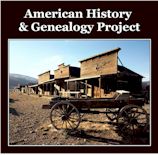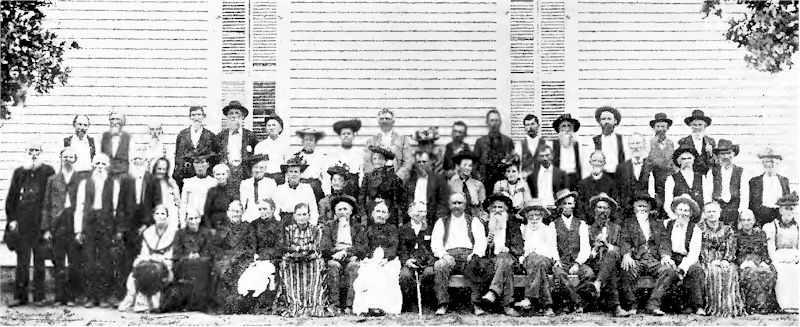 |
Eastland |
 |
The Moving Frontier Line
|
The Moving Frontier Line 1873-1881 The line of settlements in the County did not change for several years, but the force and power of the constantly increasing flow of human beings from the other States, which was stopped temporarily in the populated centers by the civil strife and the fear of the Indian in the West, could no longer be checked. The Rev. C. Brashears, who came to the county in the autumn of 1872, writes of the conditions existing at that time: "Six families at or near McGough Springs, three families at Mansker Lake, one settlement at Flannagan's, consisting of a cow-ranch and one family; another on South Palo Pinto Creek of two or more families; these, with two families on the Sabanno, three at Ellison's Spring, and three or four at Desdemona, made up the entire population of Eastland County when I came here. "This was a fine stock country. Game was plentiful, such as bear, wolf, deer, turkey, buffalo, a few panther, wild cat, catamount, fox, opossum, skunk, and Indian. There were wild horses here at that time and any number of cattle. This was then a fine hog country, as there was always a heavy mast. Hogs were plentiful. When it is remembered that in 1860 there were ninety-nine inhabitants in Eastland County, and in 1870 only eighty-eight (including women and children), the conditions prevailing at that time in this section will more readily be appreciated. From Mr. Brashear's letter it will be seen that the frontier line of 1863 still existed in 1872, one year before the County was organized, and was marked by Flannagan's Ranch, McGough Springs, and Jewell. Although the increase in population in one year was sufficient to organize the County as recorded in the following chapter, yet the name of no man has been discovered who located west of the line above referred to prior to 1872. It is pleasant to note, however, that once the County was organized and its possibilities known, a steady influx of people began. In 1873 scarcely the seventy-five required number of voters could be found; in 1875, when the County Town was permanently located at Eastland City, there were one hundred and twenty-three voters, and in 1880 the census gave four thousand eight hundred and fifty-five as the population of the County. On November 25, 1874, the last raid of Indian through this County occurred.1 They came down by the eastern route, and on Barton's Creek Mr. Ellison was shot off his horse, and Mr. Leslie killed on Indian Creek. Messrs. Sam Allen, Silas C. Buck, Tom Gibson and Mack Singleton were four of eighteen men who chased the Indians one hundred and fifty miles.
During this period, 1873-1881, the old line of settlements was wiped out. Six families (names given elsewhere), stopped in the Rising Star Country; Major Munn, who had to go eighteen miles to McGough Springs for his mail (which Postmaster Father McGough kept in a shoe-box under his bed), settled at Nimrod, and lives on the land he first purchased; E. Y Weddington grazed his cattle in the northwestern part of the County, as also did his neighbors, Charnel Hightower, Billy Stevens, John, Crowd, Bill, Hilly and Joe Dennis and Joe Funk. Mr. Drake and sons settled lower down on the Leon. In the Cisco Country were Messrs. N. Danvers, W. B. Cobb, Albert Stephens, Robert and Stuart Cone, N. Turknette, John Davis, Josh and John Morris, Lacy, Rhoads, Bunson, Townsend, T. E. Johnson, J. J. Wallace, J. P. Montgomery, John Lane, O. H. Lovelady, Frank Young, B. L. Pate, J. F. Loony, M. V. Palmer, Jim Caradine and M. B. Owens.2 Thus was the frontier line pushed farther and farther west, and the civilization of the Virginias, Carolinas, Kentucky, Pennsylvania, Georgia, Alabama and Mississippi found among this moving throng, tip-toeing to see across and venture on and on as the line strode westward. Footnotes 1. Messrs, Sam Allen, of Van Horn, and K. Pemberton, of Stephenville, are the authority for this statement. Judge Calhoun thinks a raid into Comanche County, passing through the western part of Eastland, occurred at a later date, and a little incident related by Mr. Pemberton might seem to substantiate this opinion. One day Mr, Frank Roach, who resided in the southern part of Eastland, had gone alone to mill in Comanche County. On his return he met an acquaintance, who reined up his horse by Mr. Roach's wagon. "How is it you are out alone? Aren't you afraid of the Indians?" Mr. Roach replied: "No. Me and the Indians like each other; we get along: all right." Hardly had these words passed when a squad of Indians were seen coming around a thicket straight toward them. The man put spurs to his horse and was gone. Mr. Roach leaped from his seat, cut one of his fine young mules from the harness and sprung upon his back. No sooner was this feat accomplished than the mule, on whose back man had never sat, began to pitch and to plunge, while the Indians bore down upon the defenseless man who found himself in such a close place. The mule, instead of going down the road as Mr. Roach urged him to do rushed into a thicket, which the Indians at once surrounded, laughing uproariously at the antics of the mule, and helped to keep things interesting to the man by plying him with arrows. Suddenly, however, the mule made a dash for the road and damaged his reputation by doing exactly as he was desired to do, made tracks so fast that the Indians were outdistanced. They took revenge by burning the wagon and its contents and carried off the other animal. Mr. Roach lost an eye in the encounter, but was always able to appreciate the good race that he made. 2. These names have been supplied by R. F. Weddington. R. G, Luse and I. Lamb. Doubtless there are many other names these gentlemen failed to remember. Source: History of Eastland County, Texas, by Mrs. George Langston, A. D. Aldridge & Company, Dallas, Texas, 1904.
|
